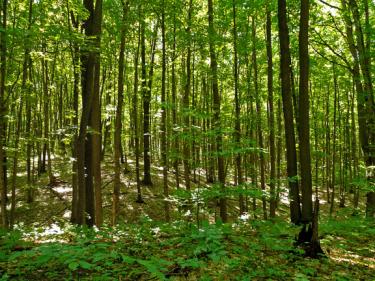Designing a Trail
The first step to building a sustainable trail is design. The following steps will get you started.
Step 1: Determine its purpose
Step 2: Plan the route
Select the corridor: Depending on the size of your woodlands, aerial photographs and topographic maps may come in handy when designing a trail. Photographs should be on a scale of at least four inches to a mile; maps at 1:24,000 (also known as 7.5-minute quadrangles). Use your MyLandPlan.org account to map your land and your existing trails.
Digital topographic maps can be downloaded for free from the U.S. Geological Survey’s U.S. Topo map site. Photographs can often be acquired from your state’s department of natural resources (forestry section), the USDA’s Farm Service Agency or USGS.
Once you’ve armed yourself with these visual guides, take note of features in the landscape such as hills, streams, wetland and boulders, as well as existing roads, tracks and other points of interest. Then decide on your trail’s trajectory.
Do some field reconnaissance: There’s no replacement for scouting, so once you’ve decided on a trajectory, walk your land. The best time of year to see the landscape is late fall, but try to scout in all four seasons to identify the highlights and the hazards of the corridor. For example, spring may bring high water and temporary ponds you’ll want to avoid; summer is when foliage is most dense; and, fall offers color and distant vistas. As you scout, mark points of interest, obstacles, and existing trails and roads on a map or record their GPS coordinates.
What to look for: Ridgelines, bluffs and cliffs, and stream bottoms, because they all offer natural trail routes, as well as points of interest (unusual landforms, different types of vegetation, viewpoints, lakes, waterfalls and other hydrologic features, archeological or historic sites, and wildlife habitats, such as cliffs or caves).
What to avoid: Wetlands and swamps, very rock or steep slopes, the edges of streams, thickets of invasive plants, old homesteads with wells or cisterns, active farmland and property boundaries. Also avoid threatened or endangered flora, fauna, geology, and natural plant communities. If you’re not sure whether you’ve got any of these on your property, ask your state’s department of natural resources.
Note: If your trail crosses over streams, wetlands or roads, you may need a permit from a local water authority or road authority. Make sure to obtain any permits before you begin construction.
Step 3: Establish design standards
These standards will guide the construction of your trail(s), so it’s worth spending some time on them before you starting flagging its location. They should include trail configuration and length, tread surface and width, clearing width and height, grade, turning radius, and more. For example, the tread width for a trail that will be used to travel in two directions should be twice that of one-way travel; and the turning radius of a trail that will be used for mountain biking and cross-country skiing should be longer than for hiking. And remember, the trail grade makes the difference between drudgery and delight: Aim to keep the average grade at 4 to 6 percent, then increase or decrease it for short distances to keep the experience interesting.
Learn more
How can I get more tips?
It’s simple! Enter your email below.


